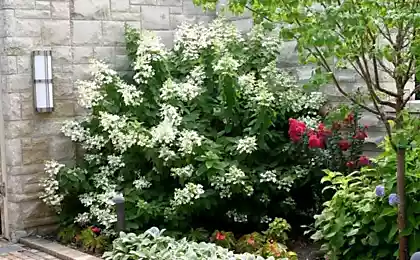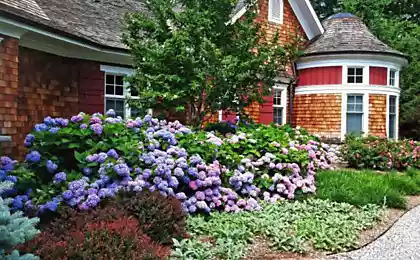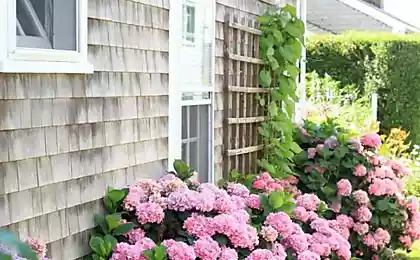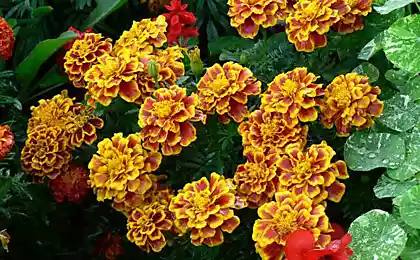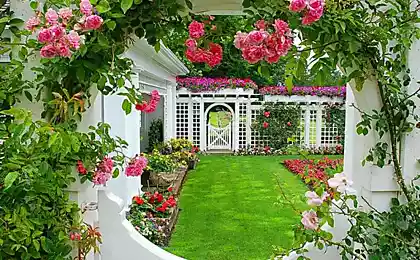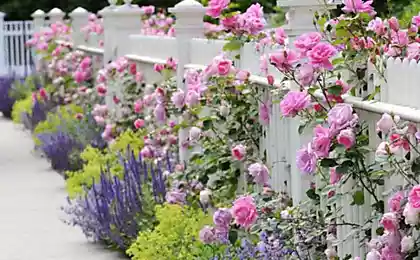572
Hydrangeas: a riot of colors in your garden
Hydrangea (Hydrangea) was imported to Central Russia from Japan and China, and immediately caught the fancy of a huge number of landlords. It is relatively hardy and grows well. However, its main distinguishing feature is a stunning palette of amazingly beautiful blossoms from white and pale pink to blue, light blue, purple and fuchsia.

Moreover, their color can be adjusted independently, achieving more variety of shades, so a few bushes of hydrangeas will be a bright ornament to any garden.
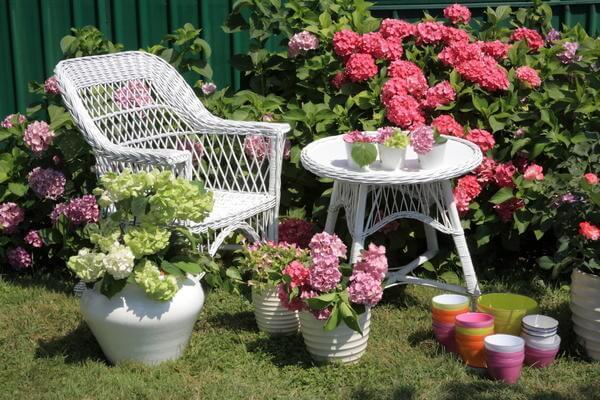
AppearanceHeight of plants depends on the species and variety. In the middle zone of Russia bigleaf hydrangea or garden, reaches a height of 2 m, the tree – 2.5 m, paniculate, up to 3-4 m.
Bigleaf hydrangeas have large inflorescences with a diameter of 15-20 cm it Blooms almost all summer: from late June to September.

When and where planted hydrangeas
To the ground she is quite picky especially well in acidic soils. Otherwise, the hydrangea just will not bloom and will lose all its charm. To increase the acidity of the soil with a special fertilizer. They can be liquid or granular.
For example, Pokon — complex fertilizer in the form of granules. It has all the necessary substances in the right proportion. When planting new plants is to be paid twice a year (spring and autumn).
Fertilizer for hydrangeas you can prepare yourself by mixing ammonium nitrate, superphosphate and potassium sulphate. It is made at planting, 2 years after that the plant is not fed.
For better growth of hydrangea the soil around it is recommended to mulch (peat, pine needles, wood chips or a layer of compost).
To improve the soil, you can use red peat moss and compost. In addition, in the ground when planting, make a small amount of coarse sand.
Planting hydrangeas1. Prepare seat size 50х50х50 see
2. Add the sand and quality compost. Plant a plant, taking care not to bury the root neck.
3. Watering and mulching.
Hydrangea good in a single (solitary) planting, but more effective in homogeneous groups. Her suit flowering hedges.

Primary care of the hydrangeas
1. IrrigationIs the main component of care. Hydrangea loves water, so watering should be daily and regular

2. TrimmingThis "wild" beauty is actively growing and is in need of competent pruning.
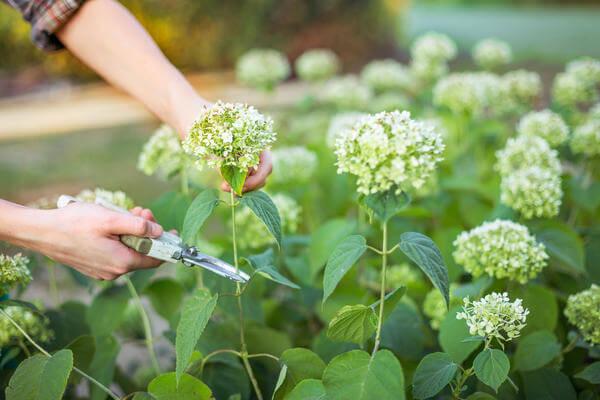
Otherwise, the bloom wanes, and plants lose their decorative effect.
3. The tying of bushesBecause bushes hydrangea tree is quite massive, the better, even when landing, set the prop to which you can tie up the shoots.
The types of hydrangeas
Hydrangea tree (Нydrangea arborescens)based On it, derived a lot of varieties with large hemispherical inflorescences and beautiful heart-shaped leaves.

Grows well in a sheltered place, better than others tolerate lime in the soil, demanding to soil fertility and its moisture content. For a more lush flowering is recommended several times during the growing season after watering to loosen the soil in a radius of several centimeters around the plant to increase the access of oxygen to the roots.
The hydrangea tree and its varieties in March thinned out, leaving depending on the age and size of the shrub 6-12 only branches that are pruned to 2-3 buds of the old wood. She tolerates frosty winter shelter spruce branches in the first years of planting.
Hydrangea paniculata (Нydrangea paniculata)is the Most frost-resistant species. Fast growing, undemanding. Hallmark – white conical inflorescences up to 30 cm. it has a very long flowering period: from mid-June until October.
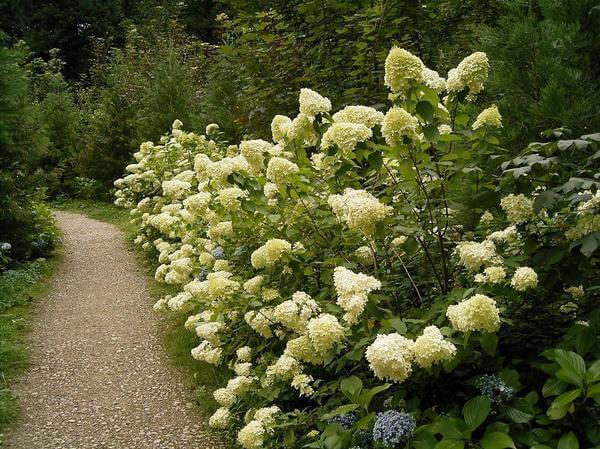
Hydrangeas prefer slightly acidic soil, so 2 times a month they poured acidified water for the preparation of which will need 1 tablespoon of citric acid per 10 liters of water. The resulting solution is poured at the roots. On average, this procedure is carried out 2 times a month and allows you to achieve a more spectacular flowering.
The plant tolerates winter conditions of Central Russia, however, it should be covered for winter spruce branches.
The bigleaf hydrangea (Hydrangea macrophylla)the Most popular hydrangea, widely represented at the Russian and Dutch suppliers. She has a lot of varieties with large buds.
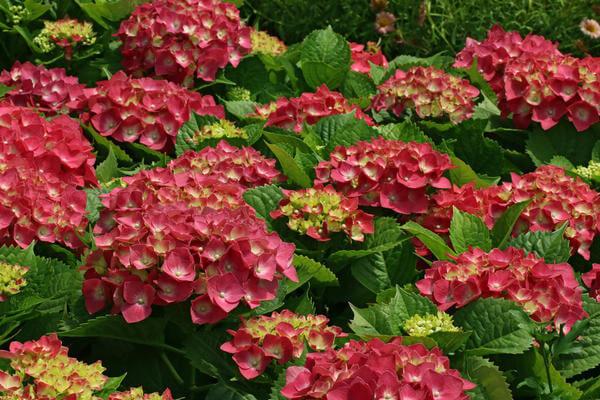
They bloom in summer on the shoots of last year, so after flowering you need to cut the weakened shoots and remove the dried blossoms, along with three or four closest leaves. Old and not flowering strong flowering shoots cut to ground level.
How to change the color of the blossoms We love and appreciate hydrangeas for their luxurious and diverse flowering.
But in nature they are found only two colors of blooms: white and light pink. All the other colourings are obtained by means of special preparations:
Pokon "Blue hydrangea" — the preparation for obtaining and maintaining blue and blue colors. Fertilizer must be dissolved in water in a ratio of 2 scoops in 1 litre of water and to bring him under the roots of the hydrangea after watering. This is done in the fall. Bona Forte "rainbow" — the drug to change the white and pink colors to blue. It is dissolved in water at the rate of 1 tsp. of fertilizer per 2 gallons of water. Also make after watering. What kind of hydrangea is growing in your garden? published
P. S. And remember, only by changing their consumption — together we change the world! © Join us at Facebook , Vkontakte, Odnoklassniki
Source: 7dach.ru/OBI/gortenzii-buystvo-krasok-v-vashem-sadu-34388.html

Moreover, their color can be adjusted independently, achieving more variety of shades, so a few bushes of hydrangeas will be a bright ornament to any garden.

AppearanceHeight of plants depends on the species and variety. In the middle zone of Russia bigleaf hydrangea or garden, reaches a height of 2 m, the tree – 2.5 m, paniculate, up to 3-4 m.
Bigleaf hydrangeas have large inflorescences with a diameter of 15-20 cm it Blooms almost all summer: from late June to September.

When and where planted hydrangeas
- In the middle zone of Russia and North of hydrangea macrophylla and its cultivars traditionally planted in the spring, only in the warm season in mid — may, and winter in the clean room with the temperature +4... +10 °C, because it does not tolerate frost.
- In southern regions, plants with developed root system can be planted in the autumn: here they spend the winter in the open ground with shelter spruce branches
- And only on the black sea coast of the Krasnodar territory and the southern coast of Crimea hydrangeas tolerate the winter without shelter.
To the ground she is quite picky especially well in acidic soils. Otherwise, the hydrangea just will not bloom and will lose all its charm. To increase the acidity of the soil with a special fertilizer. They can be liquid or granular.
For example, Pokon — complex fertilizer in the form of granules. It has all the necessary substances in the right proportion. When planting new plants is to be paid twice a year (spring and autumn).
Fertilizer for hydrangeas you can prepare yourself by mixing ammonium nitrate, superphosphate and potassium sulphate. It is made at planting, 2 years after that the plant is not fed.
For better growth of hydrangea the soil around it is recommended to mulch (peat, pine needles, wood chips or a layer of compost).
To improve the soil, you can use red peat moss and compost. In addition, in the ground when planting, make a small amount of coarse sand.
Planting hydrangeas1. Prepare seat size 50х50х50 see
2. Add the sand and quality compost. Plant a plant, taking care not to bury the root neck.
3. Watering and mulching.
Hydrangea good in a single (solitary) planting, but more effective in homogeneous groups. Her suit flowering hedges.

Primary care of the hydrangeas
1. IrrigationIs the main component of care. Hydrangea loves water, so watering should be daily and regular

2. TrimmingThis "wild" beauty is actively growing and is in need of competent pruning.

Otherwise, the bloom wanes, and plants lose their decorative effect.
3. The tying of bushesBecause bushes hydrangea tree is quite massive, the better, even when landing, set the prop to which you can tie up the shoots.
The types of hydrangeas
Hydrangea tree (Нydrangea arborescens)based On it, derived a lot of varieties with large hemispherical inflorescences and beautiful heart-shaped leaves.

Grows well in a sheltered place, better than others tolerate lime in the soil, demanding to soil fertility and its moisture content. For a more lush flowering is recommended several times during the growing season after watering to loosen the soil in a radius of several centimeters around the plant to increase the access of oxygen to the roots.
The hydrangea tree and its varieties in March thinned out, leaving depending on the age and size of the shrub 6-12 only branches that are pruned to 2-3 buds of the old wood. She tolerates frosty winter shelter spruce branches in the first years of planting.
Hydrangea paniculata (Нydrangea paniculata)is the Most frost-resistant species. Fast growing, undemanding. Hallmark – white conical inflorescences up to 30 cm. it has a very long flowering period: from mid-June until October.

Hydrangeas prefer slightly acidic soil, so 2 times a month they poured acidified water for the preparation of which will need 1 tablespoon of citric acid per 10 liters of water. The resulting solution is poured at the roots. On average, this procedure is carried out 2 times a month and allows you to achieve a more spectacular flowering.
The plant tolerates winter conditions of Central Russia, however, it should be covered for winter spruce branches.
The bigleaf hydrangea (Hydrangea macrophylla)the Most popular hydrangea, widely represented at the Russian and Dutch suppliers. She has a lot of varieties with large buds.

They bloom in summer on the shoots of last year, so after flowering you need to cut the weakened shoots and remove the dried blossoms, along with three or four closest leaves. Old and not flowering strong flowering shoots cut to ground level.
How to change the color of the blossoms We love and appreciate hydrangeas for their luxurious and diverse flowering.
But in nature they are found only two colors of blooms: white and light pink. All the other colourings are obtained by means of special preparations:
Pokon "Blue hydrangea" — the preparation for obtaining and maintaining blue and blue colors. Fertilizer must be dissolved in water in a ratio of 2 scoops in 1 litre of water and to bring him under the roots of the hydrangea after watering. This is done in the fall. Bona Forte "rainbow" — the drug to change the white and pink colors to blue. It is dissolved in water at the rate of 1 tsp. of fertilizer per 2 gallons of water. Also make after watering. What kind of hydrangea is growing in your garden? published
P. S. And remember, only by changing their consumption — together we change the world! © Join us at Facebook , Vkontakte, Odnoklassniki
Source: 7dach.ru/OBI/gortenzii-buystvo-krasok-v-vashem-sadu-34388.html

